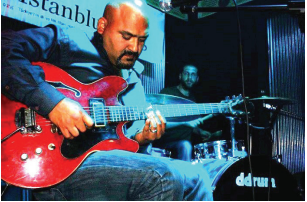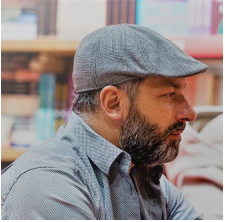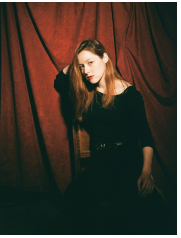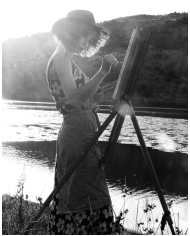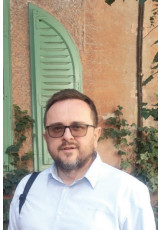Sarp Keskiner is a Turkish editor,
columnist and producer; he has
been active on the publishing and
broadcasting scenes since 1994. He
is also a cultural manager; he has
been designing and implementing
interdisciplinary projects in
collaboration with national and
international cultural networks since
2000. Currently he is providing
consultancy to independent cultural
venues, community centers, art spaces
and municipalities; in his work, he
takes local memory, intangible cultural
heritage, networking and capacity
building to the focus.
- As an author, editor and composer; societal and cultural surrounding that I am currently in
matters a lot to me, as I take inspiration from various elements around me and those elements
may vary from architecture to culinary; from sounds to narratives; from calligraphy to flora or
insights and remarks that I come across. You’ll never know what may bring inspiration to lay
down the core of a creative idea, so I keep myself open to any stimulations and go with the
flow to distil unique ideas, before I bring an idea into a shape and to the ground. As a cultural
manager and a producer, I take openness and the approach of going with the flow as essentials
of efficient networking, fully understanding of local patterns, determining needs, priorities,
abilities and limitations that frame the given conditions. I always look for where the dots lay
around waiting to be connected so that I will have the ability to create a mind map, before
designing a place-specific project or a program. Starting with a mind map is crucial in order to
decide on the most relevant space, to determine which assets and tools I may put in use and
what kind of network I need to execute the project or program. Thus; societal and cultural
habitats are natural arbiters of my creative process.
- The place of my current residency sure is the most determinant fact as I keep changing
places all the time, due to my daily routines and my professional schedule. This sure brings the
challenge of adaptation to the “next stop”; though the town, the city or the country that I
temporarily reside always brings new ideas to me. Also, regarding the saying in Turkish and
paying a respect to it; “the process of being on the road matters more than the place where
you destined to arrive.” Nonetheless, changing the country that you live in, even if it is a
temporary residence, brings you a lot of new experience, teaches you new social patterns to
enrich your way of handling, understanding and doing things in general as the change of
environment enhances your toleration, your resilience and your ability to build new kind of
collaborations. Thus, as a founding member of various arts and culture initiatives and
collectives in Izmir 1 , Turkey; where ever I go to reside, I always prefer to be a part of a
community which operates with a collective manner based on solidarity, so working with
Qendra Multimedia and Termokiss 2 community was the best opportunity up to me.
- First of all, I’m thankful to READ program to give me the chance to create and network in
Prishtina, Kosovo. Also, again I’d like to thank to Qendra Multimedia and Termokiss, for
establishing me a creative, comfortable, fertile ground to bring the exhibition of our project,
“Pedestrians on the Stoney Bridge” to this beautiful, lively city. “Pedestrians on the Stoney
Bridge” is a multi-faceted, inter-disciplinary project designed by Şafak Ersözlü 3 that included
public contemporary performances executed on historical public bridges in five towns of Izmir,
Manisa and Balikesir (Turkey) and an exhibition displaying various outputs of the project such
as a sound design of my own that brings interviews made with displaced people and Unal
Ersozlu’s poems. Regarding historical heritage and public memory, we took stone bridges as
trans-cultural assets that carry the narratives of communities; as spaces that enable random
encounters where tolerance to the “other” is mandatory. Nonetheless, we chose public
bridges on purpose in order to enable the maximum of accessibility of audience with consists
locals coming from various backgrounds, ages and genders. Thus, using those bridges gave us
the chance of putting an emphasis on equality, diversity and transition of identities. Family
photos that accompany the sound design made from the interviews are taken as a medium that
bridge the gap between yesterday and today. Video documentaries of the public
performances produced by Jack Nelson (UK), Metehan Kayan, Yazi Ece Koz (both were also
performing artists on this project) and the soundtracks composed by Nick Rothwell (UK),
establish the audiovisual groundwork of the exhibition.
Bringing the exhibition to Prishtina also led the way to completion of a touching cycle, as
curator Safak Ersozlu and his poet father Unal Ersozlu found a chance to visit their ancestral
homeland, Vushtrri. That brought a completely different vibe to the output, as we added three
poems to the exhibition that are written by family members on the way back from their
pilgrimage while I found a chance to enhance the content with my installations, photographs
and interviews that I made with creative individuals based in the city.
As a result, READ gave me the opportunity to be a part of the society in Pristine and I am
amazed with the creative, lively, innovative scene in the city while building a brand-new
network which courage me to design cultural exchange programs that aims at bringing the arts
and cultural clusters of Izmir and Pristine together, in the near future.
[1] @konserveproject – karantinamekan.com – komunitasizmir.com – bagimsizlar.org – 6x6x6izmir.com – facebook.com/ikpgplatform – soundcloud.com/kronovoxarchives

